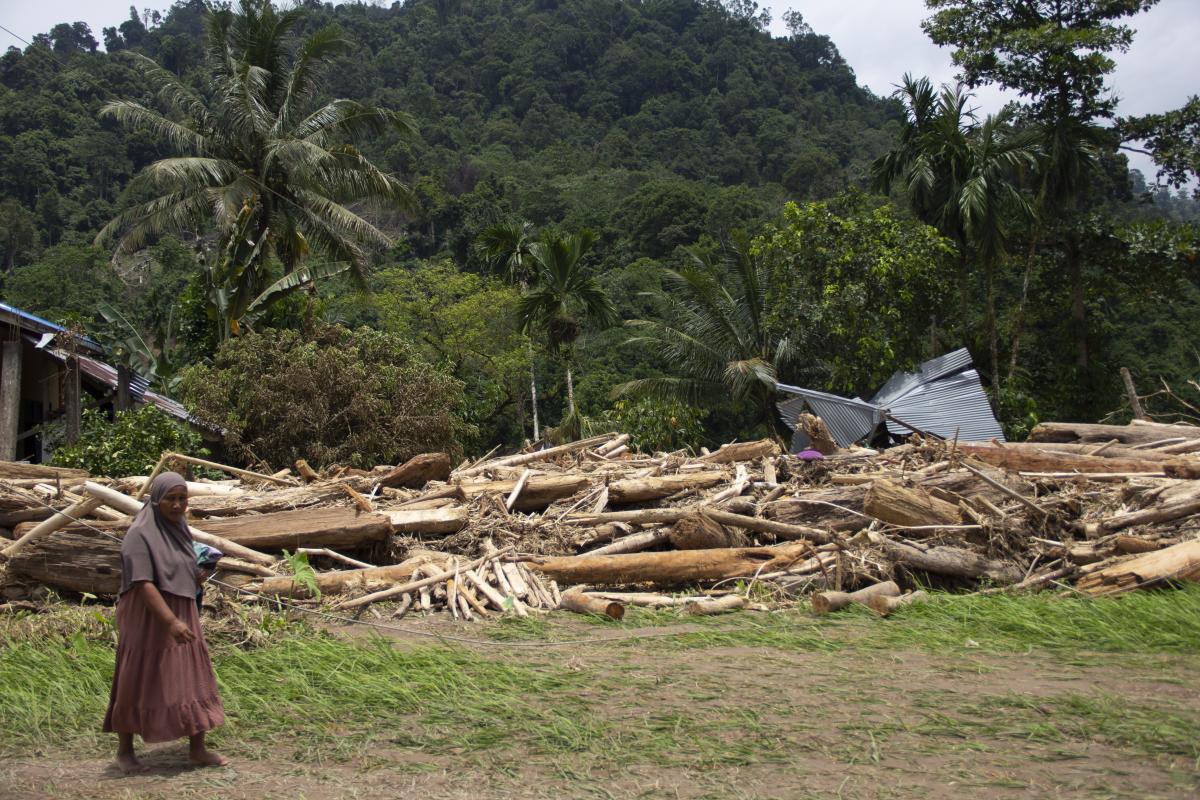
Environmental groups in Indonesia are increasingly concerned about how deforestation and environmental degradation are amplifying the impacts of natural disasters like floods, landslides, drought, and forest fires in areas such as Pesisir Selatan, West Sumatra.

Days of torrential rainfall in Indonesia's Sumatra island led to flash floods and a landslide, killing 19 people with 7 others missing. Mud, rocks, and uprooted trees swept through villages in West Sumatran province. Rescue efforts were hindered by power outages and blocked roads. Over 80,000 people sought refuge in temporary shelters. Indonesia's National Disaster Management Agency reported injuries to at least 2 villagers. Flash floods and landslides are common in Indonesia, affecting millions living near floodplains, particularly during the rainy season.

Flash floods and landslides in West Sumatra province, Indonesia, have resulted in the death of at least 26 people with 11 others missing. Rescuers are facing challenges due to power outages, damaged infrastructure, and ongoing heavy rains. More than 37,000 houses and buildings have been submerged, with significant damage to bridges, mosques, schools, and agricultural land. Indonesia, with its archipelago of over 17,000 islands, frequently experiences landslides and floods during heavy monsoon seasons.

Environmental degradation is the deterioration of the environment through depletion of resources such as quality of air, water and soil; the destruction of ecosystems; habitat destruction; the extinction of wildlife; and pollution. It is defined as any change or disturbance to the environment perceived to be deleterious or undesirable. Environmental degradation process amplify the impact of environmental issues leave lasting impacts on the environment.Environmental degradation is one of the ten threats officially cautioned by the High-level Panel on Threats, Challenges and Change of the United Nations. The United Nations International Strategy for Disaster Reduction defines environmental degradation as "the reduction of the capacity of the environment to meet social and ecological objectives, and needs".Environmental degradation comes in many types. When natural habitats are destroyed or natural resources are depleted, the environment is degraded; direct environmental degredation, such as deforestation which has readily visible; this can be caused by more indirect process, such as the build up of plastic pollution over time or the buildup of greenhouse gases that causes tipping points in the climate system. Efforts to counteract this problem include environmental protection and environmental resources management. Mismanagement that leads to degradation can also lead to environmental conflict where communities organize in opposition to the forces that mismanaged the environment.

Sumatra () is one of the Sunda Islands of western Indonesia. It is the largest island that is fully within Indonesian territory, as well as the sixth-largest island in the world at 475,807.63 km2 (182,812 mi.2), including adjacent islands such as the Simeulue, Nias, Mentawai, Enggano, Riau Islands, Bangka Belitung and Krakatoa archipelago.Sumatra is an elongated landmass spanning a diagonal northwest–southeast axis. The Indian Ocean borders the northwest, west, and southwest coasts of Sumatra, with the island chain of Simeulue, Nias, Mentawai, and Enggano off the western coast. In the northeast, the narrow Strait of Malacca separates the island from the Malay Peninsula, which is an extension of the Eurasian continent. In the southeast, the narrow Sunda Strait, containing the Krakatoa Archipelago, separates Sumatra from Java. The northern tip of Sumatra is near the Andaman Islands, while off the southeastern coast lie the islands of Bangka and Belitung, Karimata Strait and the Java Sea. The Bukit Barisan mountains, which contain several active volcanoes, form the backbone of the island, while the northeastern area contains large plains and lowlands with swamps, mangrove forest and complex river systems. The equator crosses the island at its centre in West Sumatra and Riau provinces. The climate of the island is tropical, hot, and humid. Lush tropical rain forest once dominated the landscape.Sumatra has a wide range of plant and animal species but has lost almost 50% of its tropical rainforest in the last 35 years. Many species are now critically endangered, such as the Sumatran ground cuckoo, the Sumatran tiger, the Sumatran elephant, the Sumatran rhinoceros, and the Sumatran orangutan. Deforestation on the island has also resulted in serious seasonal smoke haze over neighbouring countries, such as the 2013 Southeast Asian haze which caused considerable tensions between Indonesia and affected countries Malaysia and Singapore. The widespread deforestation and other environmental destruction in Sumatra and other parts of Indonesia has often been described by academics as an ecocide.

Environmental protection is the practice of protecting the natural environment by individuals, groups and governments. Its objectives are to conserve natural resources and the existing natural environment and, where it is possible, to repair damage and reverse trends.Due to the pressures of overconsumption, population growth and technology, the biophysical environment is being degraded, sometimes permanently. This has been recognized, and governments have begun placing restraints on activities that cause environmental degradation. Since the 1960s, environmental movements have created more awareness of the multiple environmental problems. There is disagreement on the extent of the environmental impact of human activity, so protection measures are occasionally debated.

A strong and shallow undersea earthquake measuring 6.4 struck the eastern side of Indonesia's main island of Java, causing damage but no immediate casualties. The quake occurred north of Paciran in East Java province, with two smaller quakes preceding it. Indonesia's Meteorology, Climatology and Geophysical Agency ruled out a tsunami threat but warned of aftershocks. Indonesia, located on the Pacific Ring of Fire, faces frequent seismic activity. Previous deadly quakes in the region include one in 2023 that killed 600 people in West Java and the 2018 Sulawesi quake and tsunami that claimed over 4,300 lives.

Indonesia is conducting a search for evidence of the Javan tiger's existence in the wild, following the discovery of a single strand of tiger hair in West Java that matched characteristics of the extinct species. The Javan tiger, declared extinct in the 1980s, may still roam the forests of Indonesia, sparking conservation efforts including camera traps and DNA sweeps. If proven to exist, the Javan tiger will be classified as a protected animal. Poaching and deforestation were identified as factors contributing to the tigers' extinction. Conservationists urge caution in communicating findings to prevent alerting hunters.

Environmental sociology is the study of interactions between societies and their natural environment. The field emphasizes the social factors that influence environmental resource management and cause environmental issues, the processes by which these environmental problems are socially constructed and define as social issues, and societal responses to these problems.Environmental sociology emerged as a subfield of sociology in the late 1970s in response to the emergence of the environmental movement in the 1960s. It represents a relatively new area of inquiry focusing on an extension of earlier sociology through inclusion of physical context as related to social factors.

Environmental science is an interdisciplinary academic field that integrates physics, biology, and geography (including ecology, chemistry, plant science, zoology, mineralogy, oceanography, limnology, soil science, geology and physical geography, and atmospheric science) to the study of the environment, and the solution of environmental problems. Environmental science emerged from the fields of natural history and medicine during the Enlightenment. Today it provides an integrated, quantitative, and interdisciplinary approach to the study of environmental systems.Environmental studies incorporates more of the social sciences for understanding human relationships, perceptions and policies towards the environment. Environmental engineering focuses on design and technology for improving environmental quality in every aspect.Environmental scientists seek to understand the earth's physical, chemical, biological, and geological processes, and to use that knowledge to understand how issues such as alternative energy systems, pollution control and mitigation, natural resource management, and the effects of global warming and climate change influence and affect the natural systems and processes of earth.Environmental issues almost always include an interaction of physical, chemical, and biological processes. Environmental scientists bring a systems approach to the analysis of environmental problems. Key elements of an effective environmental scientist include the ability to relate space, and time relationships as well as quantitative analysis.Environmental science came alive as a substantive, active field of scientific investigation in the 1960s and 1970s driven by (a) the need for a multi-disciplinary approach to analyze complex environmental problems, (b) the arrival of substantive environmental laws requiring specific environmental protocols of investigation and (c) the growing public awareness of a need for action in addressing environmental problems. Events that spurred this development included the publication of Rachel Carson's landmark environmental book Silent Spring along with major environmental issues becoming very public, such as the 1969 Santa Barbara oil spill, and the Cuyahoga River of Cleveland, Ohio, "catching fire" (also in 1969), and helped increase the visibility of environmental issues and create this new field of study.

Environmental justice or eco-justice, is a social movement to address environmental injustice, which occurs when poor or marginalized communities are harmed by hazardous waste, resource extraction, and other land uses from which they do not benefit. The movement has generated hundreds of studies showing that exposure to environmental harm is inequitably distributed.The movement began in the United States in the 1980s. It was heavily influenced by the American civil rights movement and focused on environmental racism within rich countries. The movement was later expanded to consider gender, international environmental injustice, and inequalities within marginalised groups. As the movement achieved some success in rich countries, environmental burdens were shifted to the Global South (as for example through extractivism or the global waste trade). The movement for environmental justice has thus become more global, with some of its aims now being articulated by the United Nations. The movement overlaps with movements for Indigenous land rights and for the human right to a healthy environment.The goal of the environmental justice movement is to achieve agency for marginalised communities in making environmental decisions that affect their lives. The global environmental justice movement arises from local environmental conflicts in which environmental defenders frequently confront multi-national corporations in resource extraction or other industries. Local outcomes of these conflicts are increasingly influenced by trans-national environmental justice networks.Environmental justice scholars have produced a large interdisciplinary body of social science literature that includes contributions to political ecology, environmental law, and theories on justice and sustainability.

Environmental laws are laws that protect the environment. Environmental law is the collection of laws, regulations, agreements and common law that governs how humans interact with their environment. This includes environmental regulations; laws governing management of natural resources, such as forests, minerals, or fisheries; and related topics such as environmental impact assessments. Environmental law is seen as the body of laws concerned with the protection of living things (human beings inclusive) from the harm that human activity may immediately or eventually cause to them or their species, either directly or to the media and the habits on which they depend.

Indonesia, officially the Republic of Indonesia, is a country in Southeast Asia and Oceania between the Indian and Pacific oceans. It consists of over 17,000 islands, including Sumatra, Java, Sulawesi, and parts of Borneo and New Guinea. Indonesia is the world's largest archipelagic state and the 14th-largest country by area, at 1,904,569 square kilometres (735,358 square miles). With over 279 million people, Indonesia is the world's fourth-most-populous country and the most populous Muslim-majority country. Java, the world's most populous island, is home to more than half of the country's population.Indonesia is a presidential republic with an elected legislature. It has 38 provinces, of which nine have special autonomous status. The country's capital, Jakarta, is the world's second-most-populous urban area. Indonesia shares land borders with Papua New Guinea, East Timor, and the eastern part of Malaysia, as well as maritime borders with Singapore, Vietnam, Thailand, the Philippines, Australia, Palau, and India. Despite its large population and densely populated regions, Indonesia has vast areas of wilderness with the world's second-highest levels of biodiversity after Brazil.The Indonesian archipelago has been a valuable region for trade since at least the seventh century when the Srivijaya and later Majapahit Kingdoms traded with entities from mainland China and the Indian subcontinent. Local rulers gradually absorbed foreign influences from the early centuries, and Hindu and Buddhist kingdoms flourished. Sunni traders and Sufi scholars later brought Islam, and European powers fought one another to monopolise trade in the Spice Islands of Maluku during the Age of Discovery. Following three and a half centuries of Dutch colonialism, Indonesia secured its independence after World War II. Indonesia's history has since been turbulent, with challenges posed by natural disasters, corruption, separatism, a democratisation process, and periods of rapid economic growth.Indonesia consists of thousands of distinct native ethnic and hundreds of linguistic groups, with Javanese being the largest. A shared identity has developed with the motto "Bhinneka Tunggal Ika" ("Unity in Diversity" literally, "many, yet one"), defined by a national language, cultural diversity, religious pluralism within a Muslim-majority population, and a history of colonialism and rebellion against it. The economy of Indonesia is the world's 16th-largest by nominal GDP and the 7th-largest by PPP. It is the world's third-largest democracy, a regional power, and is considered a middle power in global affairs. The country is a member of several multilateral organisations, including the United Nations, World Trade Organization, G20, and a founding member of the Non-Aligned Movement, Association of Southeast Asian Nations, East Asia Summit, D-8, APEC, and the Organisation of Islamic Cooperation.



Yahoo! News

Yahoo! News

https://apnews.com/author/victoria-milko

PANORA

PANORA

Wikipedia

Wikipedia

Wikipedia

PANORA

PANORA

Wikipedia

Wikipedia

Wikipedia

Wikipedia

Wikipedia